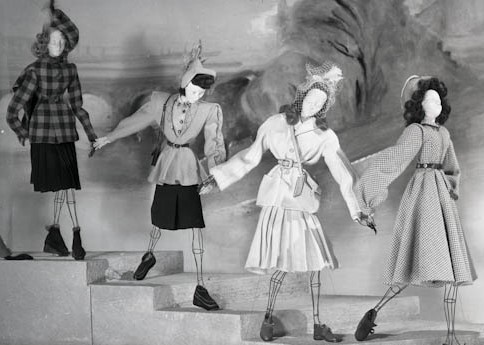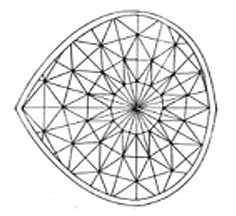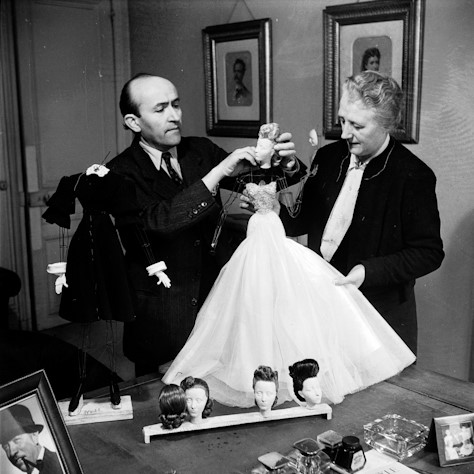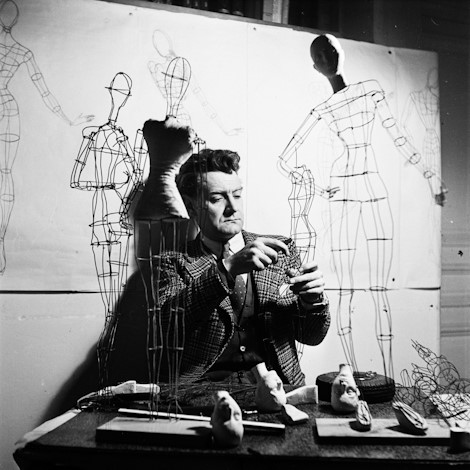Sofia Busignani
Durante il secondo conflitto mondiale era stato pressocché impossibile, o almeno molto arduo, tenere delle sfilate regolari, tanto che «Vogue Magazine» smise di riportare tale tipo di evento dal 1941 fino al 1944. Finché, i primi mesi dell’ultimo anno del conflitto la Chambre Syndicale escogitò un modo per far conoscere al mondo quanto i couturiers parigini non avevano smesso di ideare durante quegli anni. Nel 1990 Edmonde Charles-Roux, che ricoprirà il ruolo di redattore capo dell’edizione francese di «Vogue» tra il 1950 e il 1966, raccontò di come venne a sapere di questo progetto in pieno campo di battaglia:
It was there, at that nightmare bivouac, that I first heard of an exhibition that, Lee said, would have an enormous impact and that the Parisian public, so long deprived of all contact with beauty and elegance, would surely appreciate. It was being prepared with infinite care, though as yet no title had been decided. All that was known was that its whole object was to glorify French fashion and the multiple activities and specialized skills and crafts that centered around it. The Soviet army was at the Oder. Budapest had barely fallen. The Americans had landed at Marseilles, France was in ruins. But in Paris a celebration of the haute couture was being prepared! I advised Lee not to mention any of this at the officers’ mess where she was expected. The virtues of elegant living would have no chance of being seen as a priority by her audience there, One month later, March 28, 1945, the project was realized. It was the Théâtre de la Mode.

Esposto al Pavillon Marsan, il Théâtre de la Mode avrebbe attirato quasi centomila visitatori. Venne mandato in tour nelle maggiori capitali europee per arrivare a New York nella primavera del 1946, completo delle sue tredici ambientazioni e delle 237 bambole (eco delle poupées des modes) che indossavano le ultime creazioni dell’haute couture. Modiste, parrucchieri, calzolai, guantai, creatori di borse e accessori, nonché gioiellieri, avevano tutti cospirato per riprodurre l’ispirazione di ogni stilista. Vi avevano partecipato grandi nomi di artisti come Cocteau o Boris Kochno e Christian Bérard. In un teatro in miniatura, si vedevano piccoli personaggi costruiti in filo di ferro, usato dalla loro realizzatrice Elaine Bonabel, su disegno di Jean Saint-Martin, in mancanza di altro. Queste sorta di bambole indossavano le ultime creazioni dei nostri migliori couturier. Inoltre, avevano capelli veri, i loro vestiti erano fatti di materiale vero, i loro guanti minuscoli di vera pelle, i loro cappelli di vero feltro, i loro cappotti di vera pelliccia. Continua Charles-Roux:
Yet however ephemeral this banishment of the false, it had insolently restored to its place the real, the rare, the beautiful, and the luxurious. And as if part of this audacious dream, Parisians forgot present or past misery and crowded to see these dazzling little figures. They inhabited their own strange little theater world where penury had no place, where it seemed restrictions had disappeared at full speed.
Dare nuova vita ad una vecchia idea, come quella delle poupées des modes, in un periodo di crisi fu tutto merito della Chambre Syndicale de la Couture Parisienne e del suo presidente Lucien Lelong. Ma i veri istigatori del progetto furono Paul Caldaguès, un giornalista di moda, e Robert Ricci, figlio di Nina Ricci, che era stato editore e pubblicista, un uomo di comunicazione prima del tempo. Uno dei fattori più straordinari di questa impresa fu il fatto che, per la prima volta, i più grandi nome della couture parigina si ritrovavano a “sfilare”, senza distinzione di merito, nello stesso luogo.
When we remember that this was an epoch during which the different couture houses were still imprisoned in a world of prejudice and jealousy, where each was an impregnable fortress set against the other, each supported by a clan of friends, backers, those who inspired or the dynamics nonde, artists, and loyal clients, we must marvel that the strength of an idea or the din of so ambitious a project was enough to weld together all opposing forces in common enterprise.
Il Théâtre de la Mode continuò il suo giro per il mondo fino al 1947 circa, per poi cadere nel dimenticatoio. Venne restaurato nel 1988 sotto il patrocinio del Musée de la Mode et du Textile di Parigi e dagli anni Novanta è in esposizione permanente al Maryhill Museum of Art (Stato di Washington, Stati Uniti). A Edmonde Charles-Roux venne chiesto di partecipare al catalogo apportando la sua testimonianza diretta, in cui l’autrice affermò che “nel concepire il Théâtre de la Mode, la Chambre Syndicale de la Couture mostrò un raro spirito avventuroso. E la sfida era grande. Oggi, liberati da tali preoccupazioni [della guerra], siamo capaci di stupirci a sufficienza?”.
Testo tratto dalla tesi di laurea magistrale di Sofia Busignani, 1892 – 2021: la sfilata di moda e i suoi cambiamenti attraverso le pagine di “Vogue Magazine”.
Bibliografia
CHARLES-ROUX, EDMONDE, Théâtre de la Mode, Rizzoli, New York, 1991
DIEHL, MARY ELLEN, How to produce a fashion show, Fairchild Pubblications, New York, 1976
MUSÉE GALLIERA, Showtime: le défilé de mode, 3 mars – 30 juillet 2006, Paris Musées, Parigi, 2006


